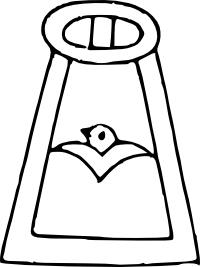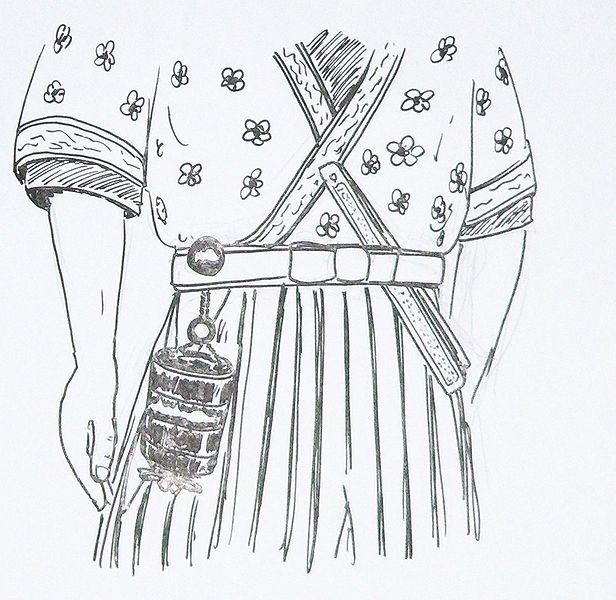Recreational research into Feudal Japan
Archive for October, 2010
Mon of the Week: Enclosed Goose
Oct 25th (a Tomobiki (友引))
At the other end of the spectrum in terms of realism from the Perching Hawk is this mon below, from the same collection of provincial samurai mon.(KJ:7) The highly stylized bird in the middle is a wild goose, and this depiction of geese is still common through the present day. Geese are associated with good news and gracefulness.(NHK Online) More mysterious is the enclosure around the goose. It bears some similarity to a piece of horse equipment (aori/泥障) that would hang from the saddle and sit between the rider’s legs and the horse’s body; these could be decorated with mon the way the plover image appears here. This explanation isn’t entirely convincing, so there could be other possibilities.
Note: This entry originally inaccurately identified the bird as a plover instead of a wild goose. Plovers were a common motif in Japanese poetry, with connotations of longevity based on their cry “chiyo” (thousands of generations).(Komuso)
In addition, one source identifies this enclosure as tongs.
On Netsuke
Oct 17th (a Shakkō (赤口))
One area of Japanese art popular with collectors are netsuke. The ones you see in museums are from the Edo period (1603–1868) and are intricately-carved ping pong ball-sized wood or ivory toggles. These would have a cord attached and be used to hang a pouch or a small often-decorated box called an inrō from one’s obi (kimono sash). Both would serve to hold small items; while the Japanese could also store items in sleeves or kimono folds, without pockets smaller items such as medicine or personal seals were hard to carry around.(en.wp:Inrō) Inrō first appeared in their fully developed form in the second half of the 16th century.(JN:24)
While the fancy carved netsuke prized by museums and collectors today didn’t happen until the Edo period, simple practical netsuke were in use earlier. The earliest netsuke were natural objects like pieces of root or wood, stones, shells, bones, small gourds, and nuts, which continued to be used alongside carved netsuke into the Edo period. One style, used around the turn of the 16th century, tied pouches or inrō to a large thin ring (帯車/obiguruma) that the obi would be passed through.(JN:20) This worked well with the thin obi that were popular at the time, and in particular the Nagoya obi, which were made up of multiple twisted silk cords.(<a href="http://fireflies viagra livraison rapide.xavid.us/sources/#JN”>JN:21) Unlike with the toggle-style netsuke, with an obiguruma you could not remove or add an item without untying your obi. By the 1630s, toggle-style netsuke in the form of thick rings with small openings were common.(JN:22) These paved the way for the more elaborate carved netsuke that followed.
Image by Rama; used under CC by-sa 2.0 fr.
Mon of the Week: Perching Hawk
Oct 4th (a Butsumetsu (仏滅))
Last week we looked at feathers, and today we look at the bird they come from. While animals are relatively rare in mon relative to Western heraldry, they are not unknown, and various birds are the most common. This is a hawk from the same collection of provincial samurai mon.
As mentioned last week, falconry was popular among the samurai class, and this hawk, tethered to a perch, is a such a captive bird. It is an unusually realistic depiction for an early mon, with high levels of detail and some three-dimensional aspects to the drawing. This depiction of the hawk did not catch on, and more stylized and flat designs, without an accompanying perch, remained the general rule until modern times.(KJ:7)



